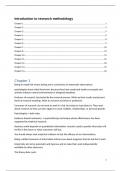Introduction to research methodology
Chapter 1................................................................................................................................................1
Chapter 2................................................................................................................................................3
Chapter 3................................................................................................................................................5
Chapter 4................................................................................................................................................6
Chapter 5................................................................................................................................................8
Chapter 6................................................................................................................................................9
Chapter 7..............................................................................................................................................10
Chapter 8..............................................................................................................................................12
Chapter 10............................................................................................................................................13
Chapter 11............................................................................................................................................16
Chapter 12............................................................................................................................................18
Chapter 13............................................................................................................................................19
Chapter 14............................................................................................................................................20
Chapter 1
Being an empiricist means basing one’s conclusions on systematic observations.
psychologists know what they know, because they have conducted studies on people and
animals acting in natural environments or designed situations.
Producer of research: fascinated by the research process. Write up their results and present
them at research meetings. Work as research scientists or professors.
Consumer of research: do not want to work in a lab, but enjoy to read about is. They read
about research so they can later apply it to work, hobbies, relationships, or personal growth.
Psychologists = both roles.
Evidence-based treatments: A psychotherapy technique whose effectiveness has been
supported by empirical research.
Business world depends on quantitative information: research used to predict what sales will
be like in the future or what consumers will buy.
You should always seek empirical evidence to test the efficacy of our interventions.
Being a skilled consumer of information informs you about programs that do and don’t work.
Empiricists aim to be systematic and rigorous and to make their work independently
verifiable by other observers.
The theory-data cycle:
1
, - Collect data to test, change, or update theories.
- First step: ask particular set of questions that reflect your theory.
- Next: make specific predictions, which you tested by collecting data. If initial
prediction was wrong, you use the data outcome to change idea about the problem.
Cupboard theory: mother is valuable to a baby, because she is a source of food. Over time,
sight of mother acquires positive value, because she is the cupboard from which food comes.
Comfort theory: babies are attached to their mothers because of the comfort of their warm,
fuzzy fur.
Theory: set of statements (as simple as possible)
that describes general principles about how
variables relate to each other.
Hypothesis (prediction): the specific outcome the
researcher will observe in a study if the theory is
accurate.
Data: set of observations. Data can support or
challenge the theory, depending on whether the
data is consistent with the hypothesis based on
the theory.
Preregistered hypotheses: after study design, but
before data collecting, the researcher states the expected outcome publicly.
Scientists don’t use prove; they say that the study’s data support or are consistent with a
theory.
Replication: study is conducted again to test whether the result is consistent.
Evaluation based on weight of the evidence: collection of studies, including replications, of
the same theory.
Falsifiability is a characteristic of good theories – theory should lead to hypotheses that
could fail to support the theory.
Science can become self-correcting: discover own mistaken theories and corrects them.
Merton’s scientific norms:
- Universalism: claims are evaluated according to their merit, independent of the
researcher’s credentials or reputation. The same preestablished criteria apply to all
scientists and all research.
- Communality: Scientific knowledge is created by a community and its findings belong
to the community.
- Disinterestedness: scientists strive to discover the truth whatever it is; they are not
swayed by conviction, idealism, politics, or profit.
2
, - Organized skepticism: scientists question everything, including own theories, widely
accepted ideas, and ancient wisdom.
Applied research: done with practical problem in mind. Researchers conduct their work in a
local, real-world context.
Basic research: enhance the general body of knowledge rather than to address a specific,
practical problem.
Translational research: use of lessons from basic research to develop and test applications to
health care, psychotherapy, or other forms of treatment and intervention. Bridge between
basic and applied research.
Peer-review: journal sends paper to experts on the subject. They comment how important
the work is, how it fits with the existing knowledge, how competently research was done,
and how convincing the results are.
Journalism: secondhand report about the research.
Journalist become interested in study through press release written by the scientist’s
university/ hearing scientists talk about their work.
Mozart effect: journalists might misrepresent science when they write for a popular
audience.
Chapter 2
Own experiences are powerful sources of information.
Do not base beliefs solely on personal experience we don’t have a comparison group
(enables us to compare what would happen both with and without the thing we are
interested in).
If a change has occurred, we often can’t be sure what caused it. Too much going on at once.
Confounds: possible explanations for an outcome. Occurs when you think one thing caused
an outcome, but other things changed, so you are confused about what the cause really was.
Confederate: actor playing a specific role for the experimenter.
In controlled study, researchers can set up the conditions to include at least one comparison
group.
Results of behavioral research are probabilistic: its findings do not explain all cases all of the
time. The conclusions are meant to explain a proportion of the possible case.
In practice: scientific conclusions are based on patterns that emerge only when researchers
set up comparison groups and test many people.
Intuition: using our hunches about what seems natural, or attempting to thing about things
logically can lead us to make less effective decisions (intuition can be biased).
3





